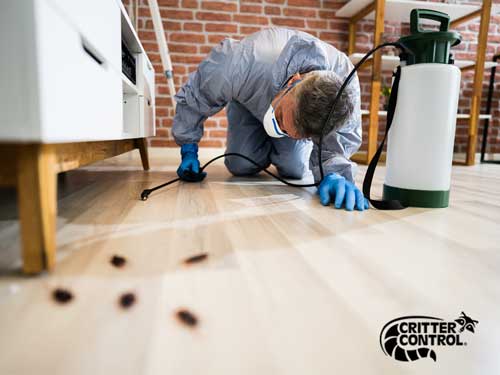Specialist A1 Charlotte Bed Bug Exterminator - Top Quality Service Ensured
Specialist A1 Charlotte Bed Bug Exterminator - Top Quality Service Ensured
Blog Article
Bed Insect Therapy Break Down: Contrasting Chemical Vs. Non-Chemical Solutions
In the realm of bug control, specifically when handling the consistent concern of bed pests, the selection between chemical and non-chemical treatment solutions can be a crucial one. Both techniques supply unique benefits and downsides, influencing variables such as effectiveness, security considerations, and overall price. By taking a look at the nuanced information of each technique, a more clear understanding of which path to pursue in addressing a bed insect infestation can be achieved.
Effectiveness of Chemical Therapies
Chemical therapies for bed bug invasions have actually been extensively identified for their fast and potent efficiency in getting rid of these bugs. When thinking about the efficiency of chemical treatments, it is important to recognize that they can offer a fast and extensive option to a bed insect issue. Specialist pest control specialists frequently rely upon insecticides to target bed insects at numerous phases of their life cycle, consisting of fairies, adults, and eggs. These chemicals usually work by disrupting the bed bugs' nerves, causing paralysis and ultimate death.
In addition, chemical treatments have the benefit of providing recurring impacts, suggesting that they can remain to remove bed insects also after the first application. This residual activity is particularly advantageous in combating any possible re-infestations. Additionally, the fast activity of chemical treatments can bring alleviation to people dealing with serious bed insect infestations, enabling them to gain back control of their living rooms swiftly.
Safety Problems With Chemical Solutions
One vital aspect that requires cautious factor to consider when utilizing chemical services for bed bug treatment is guaranteeing the security of residents and the atmosphere. Exposure to certain chemicals made use of in bed insect therapies can lead to respiratory problems, skin irritation, or other adverse responses, particularly in people with pre-existing problems or sensitivities.
Moreover, the environmental influence of chemical remedies is one more significant factor to consider. Some pesticides utilized in bed bug therapies may be damaging to valuable bugs, wildlife, and ecological communities if they seep into the dirt or water supply. It is necessary to utilize chemical therapies sensibly, complying with safety standards, and taking into consideration less toxic alternatives to alleviate these threats and make sure the risk-free and effective monitoring of bed pest infestations.
Benefits of Non-Chemical Approaches
Considering the prospective safety worries and ecological effect linked with chemical solutions for bed insect treatment, checking out non-chemical strategies provides a promising option with several unique benefits. Non-chemical therapies are eco pleasant, as they do not add to air or water air pollution, making them a lasting choice for parasite control.
In addition, non-chemical services can be reliable in targeting bed insects, consisting of hard-to-reach locations where chemical therapies may not penetrate - A1 bed bug exterminator charlotte. website here Methods such as heat treatment, vacuuming, vapor cleansing, and cushion encasements offer thorough elimination without the usage of damaging chemicals.
Limitations of Non-Chemical Treatments

Additionally, non-chemical treatments typically call for several applications to accomplish effective obliteration. This can be taxing and may not constantly assure complete elimination of all bed bugs and their eggs, specifically in hard-to-reach or concealed locations.
Additionally, the success of non-chemical therapies greatly relies upon proper application and thoroughness, which can be testing for individuals without professional competence. Inadequate application of non-chemical techniques may result in incomplete eradication, leading to relentless problems and the demand for additional treatments.
Consequently, while non-chemical therapies have their advantages, it is important to recognize these constraints and consider them when determining the most reliable approach for taking care of bed bug infestations.
Price Comparison: Chemical Vs. Non-Chemical Options
Provided the restrictions associated with non-chemical treatments, an essential aspect to assess in the context of bed pest management is the expense comparison in between chemical and non-chemical options. In comparison, non-chemical therapies like heat therapy or vapor can be much more pricey, with expenses ranging from $1,000 to $6,000 for an entire home. While the initial price of chemical treatments may appear lower, multiple therapies may be needed to fully eliminate the problem, possibly boosting the total cost.
Verdict

Considering the possible safety issues and ecological impact connected with chemical solutions for bed pest treatment, exploring non-chemical techniques presents an encouraging alternative with a number of distinctive benefits.Offered the YOURURL.com restrictions associated with non-chemical therapies, an essential facet to assess in the context of bed pest management is the expense comparison between chemical and non-chemical choices. In comparison, non-chemical therapies like heat therapy or vapor can be much more pricey, with prices ranging from $1,000 to $6,000 for an entire home. While the initial price of chemical treatments might appear reduced, numerous therapies may be called for to fully remove the infestation, possibly increasing the general expense.In verdict, when comparing chemical and non-chemical bed insect therapy options, it is essential to consider effectiveness, safety and security, advantages, limitations, and expense.
Report this page